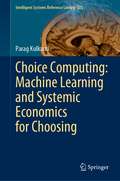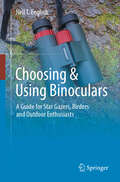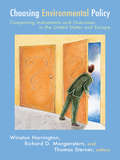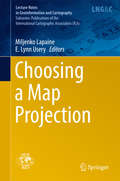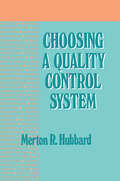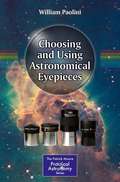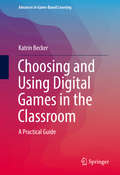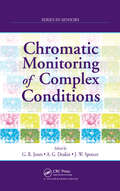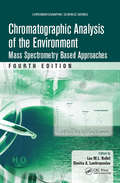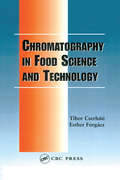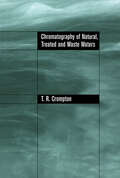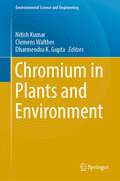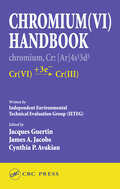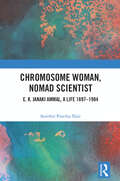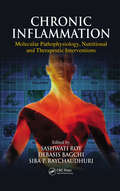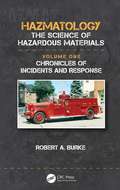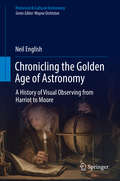- Table View
- List View
Chocolate and Health
by Andrea Poli Ario Conti Rodolfo Paoletti Francesco VisioliCocoa and chocolate are the subjects of much research in the fields of food chemistry, food technology, and health science. We now know that cocoa contains a remarkable number of bioactive compounds, and these are being tested in humans to verify their disease prevention characteristics. This state of the art text thoroughly explores the different aspects of the relationship between chocolate and health. After introductory discussion of the historical background, careful attention is devoted to technological developments designed to improve the health-giving qualities of chocolate and biochemical and clinical trials of cocoa and its components. Various health impacts of cocoa and chocolate are thoroughly evaluated, including acute vascular effects and effects on blood pressure, blood lipids, and platelets. Psychological drivers of chocolate consumption and craving are also considered. Readers will find this book to be a rich source of essential information on cocoa and chocolate, their purported health-giving qualities, and the advances that are being made in this area.
Chocolate in Health and Nutrition (Nutrition and Health)
by Victor R. Preedy Ronald Ross Watson Sherma ZibadiChocolate in Health and Nutrition represents the first comprehensive compilation of the newest data on the actions of the flavonoids and microorganisms associated with the beneficial effects of chocolate. This unique text provides practical, data-driven resources based upon the totality of the evidence to help the reader understand the basics, treatments and preventive strategies that are involved in the understanding of the role chocolate may play in healthy individuals as well as those with cardiovascular disease, diabetes or neurocognitive declines. Of equal importance, critical issues that involve patient concerns, such as dental caries and food preferences in children, potential effects on weight gain, addiction and withdrawal are included in well-referenced, informative chapters. The latest research on the role of chocolate in normal health areas including mood, pain and weight management, cardiovascular disease and related conditions are presented. Chocolate in Health and Nutrition provides health professionals in many areas of research and practice with the most up-to-date, well referenced and comprehensive volume on the current state of the science and medical uses of chocolate.
Choice Computing: Machine Learning and Systemic Economics for Choosing (Intelligent Systems Reference Library #225)
by Parag KulkarniThis book presents thoughts and pathways to build revolutionary machine learning models with the new paradigm of machine learning to adapt behaviorism. It focuses on two aspects – one focuses on architecting a choice process to lead users on the certain choice path while the second focuses on developing machine learning models based on choice paradigm. This book is divided in three parts where part one deals with human choice and choice architecting models with stories of choice architects. Second part closely studies human choosing models and deliberates on developing machine learning models based on the human choice paradigm. Third part takes you further to look at machine learning based choice architecture. The proposed pioneering choice-based paradigm for machine learning presented in the book will help readers to develop products – help readers to solve problems in a more humanish way and to negotiate with uncertainty in a more graceful but in an objective way. It will help to create unprecedented value for business and society. Further, it will unveil a new paradigm for modern intelligent businesses to embark on the new journey; the journey of transition from shackled feature rich and choice poor systems to feature flexible and choice rich natural behaviors.
Cholesteric Liquid Crystals: Dielectric and Optical Applications (Engineering Materials)
by Pankaj Kumar Vinayak Adimule Vandna SharmaThis book highlights the latest developments and advancements in cholesteric liquid crystals. It covers a wide range of techniques to develop/modify the cholesteric liquid crystal systems with various optically active chiral dopants. It presents the unexplored features of cholesteric liquid crystals, their diverse properties such as fluorescence, photoluminescence, utility in optical smart windows, optical switching states, energy, and sensor usage with the modification by various carbon-based nanomaterials as intercalating substances. The book examines developments in the field of size and shape of cholesteric liquid crystals. In summary, the book is essential for readers to understand all parameters of cholesteric liquid crystals relating to the device architectures, techniques of formation, optical storage applications, display properties, and various diversified applications in the field of optical smart windows, molecular switches, etc.
Choosing & Using Binoculars: A Guide for Star Gazers, Birders and Outdoor Enthusiasts
by Neil T. EnglishBinoculars are life enhancing instruments, uniquely capable of bringing the intricacies of nature into sharp focus. Whether it be birds, majestic lakes and seas, alpine vistas, wild animals or exploring the glories of the night sky, anyone interested in buying binoculars today will be faced with a bewildering number of different models to choose from! This book walks the reader through the fascinating world of binoculars, past and present, while exploring all of the main binocular types, their desirable features, how to test out and narrow down the choices a prospective customer should make, as well as looking at some of the best and most-sought-after binoculars money can buy. Uniquely experienced writer and binocular enthusiast, Dr Neil English, takes the pain out of narrowing down the search for your ideal binocular, whether your budget is $50 or $5,000. Dr English explores many of the timeless beauties of the binocular world, crafted by top European and Japanese manufacturers, such as Swarovski, Zeiss, Nikon, Leica and others. Sumptuously illustrated throughout with full color images, Choosing & Using Binoculars decodes all the technical jargon without sacrificing accuracy and presents the world’s best compendium of binocular literature for the birder, hunter, inveterate traveler, nature enthusiast and star gazer. Don’t leave home without it!
Choosing Environmental Policy: Comparing Instruments and Outcomes in the United States and Europe
by Thomas Professor Sterner Winston Professor Harrington Richard D. MorgensternThe two distinct approaches to environmental policy include direct regulation-sometimes called 'command and control' policies-and regulation by economic, or market-based incentives. This book is the first to compare the costs and outcomes of these approaches by examining realworld applications. In a unique format, paired case studies from the United States and Europe contrast direct regulation on one side of the Atlantic with an incentivebased policy on the other. For example, Germany?s direct regulation of SO2 emissions is compared with an incentive approach in the U.S. Direct regulation of water pollution via the U.S. Clean Water Act is contrasted with Holland?s incentive-based fee system. Additional studies contrast solutions for eliminating leaded gasoline and reducing nitrogen oxide emissions, CFCs, and chlorinated solvents. The cases presented in Choosing Environmental Policy were selected to allow the sharpest, most direct comparisons of direct regulation and incentive-based strategies. In practice, environmental policy is often a mix of both types of instruments. This innovative investigation will interest scholars, students, and policymakers who want more precise information as to what kind of 'blend' will yield the most effective policy. Are incentive instruments more efficient than regulatory ones? Do regulatory policies necessarily have higher administrative costs? Are incentive policies more difficult to monitor? Are firms more likely to oppose market-based instruments or traditional regulation? These are some of the important questions the authors address, often with surprising results.
Choosing a Map Projection (Lecture Notes in Geoinformation and Cartography)
by Miljenko Lapaine E. Lynn UseryThis book offers a much-needed critical approach to the intelligent use of the wide variety of map projections that are rapidly and inexpensively available today. It also discusses the distortions that are immanent in any map projection. A well-chosen map projection is one in which extreme distortions are smaller than those in any other projection used to map the same area and in which the map properties match its purpose. Written by leading experts in the field, including W. Tobler, F. C. Kessler, S. E. Battersby, M. P. Finn, K. C. Clarke, V. S. Tikunov, H. Hargitai, B. Jenny and N. Frančula. This book is designed for use by laymen. The book editors are M. Lapaine and E. L. Usery, Chair and Vice-Chair, respectively, of the ICA Commission on Map Projections for the period 2011-2015.
Choosing a Quality Control System
by Merton R. HubbardThere are over 24 quality control systems recommended for the control and improvement of quality and process; there are over 30 techniques and buzzwords suggested for implementing these systems and to assist in learning about these systems and techniques; there are well over 200 courses, seminars, programs, and conferences available. This book disc
Choosing and Using Astronomical Eyepieces (The Patrick Moore Practical Astronomy Series)
by William PaoliniA valuable reference that fills a number of niches including that of a buyer's guide, technical desk reference and observer's field guide. It documents the past market and its evolution, right up to the present day. In addition to appealing to practical astronomers - and potentially saving them money - it is useful both as a historical reference and as a detailed review of the current market place for this bustling astronomical consumer product. What distinguishes this book from other publications on astronomy is the involvement of observers from all aspects of the astronomical community, and also the major manufacturers of equipment. It not only catalogs the technical aspects of the many modern eyepieces but also documents amateur observer reactions and impressions over the years, using many different eyepieces. Eyepieces are the most talked-about accessories and collectible items available to the amateur astronomer. No other item of equipment commands such vigorous debate, or has evolved into such a remarkable array of forms and functions. 'Choosing and Using Astronomical Eyepieces' provides a vast amount of reference material to point readers towards the best buys and the right eyepieces for different kinds of observing.
Choosing and Using Digital Games in the Classroom: A Practical Guide (Advances in Game-Based Learning #1)
by Katrin BeckerThis book presents an in-depth overview of the uses of digital games in education, from K-12 up through post-secondary. Beginning with a look at the history of games in education and the context for digital games, this book guides readers through various methods of serious game implementation, including the Magic Bullet Model, which focuses on the player's point of view of the game experience. The book also includes methods of measuring the effects of games in education and guidance on creating digital game-based learning lesson plans.
Chromatic Monitoring of Complex Conditions (Series in Sensors)
by Joseph W. Spencer Gordon Rees Jones Anthony G. DeakinExplaining the chromatic methodology for the intelligent monitoring of complex systems, Chromatic Monitoring of Complex Conditions demonstrates that chromatic processing is analogous to human vision yet also extends into a wide range of nonoptical domains.Taking a practical approach that utilizes many examples and graphs, the book presen
Chromatographic Analysis of the Environment: Mass Spectrometry Based Approaches, Fourth Edition (Chromatographic Science Series)
by Leo M. L. Nollet & Dimitra A. LambropoulouThis detailed handbook covers different chromatographic analysis techniques and chromatographic data for compounds found in air, water, and soil, and sludge. The new edition outlines developments relevant to environmental analysis, especially when using chromatographic mass spectrometric techniques. It addresses new issues, new lines of discussion, and new findings, and develops in greater detail the aspects related to chromatographic analysis in the environment. It also includes different analytical methodologies, addresses instrumental aspects, and outlines conclusions and perspectives for the future.
Chromatographic Processes: Modeling, Simulation, and Design
by Roger-Marc NicoudAddressing all aspects of the design, modeling and simulation of chromatographic processes, this result-oriented primer provides a practical guide to all the necessary approaches, methodologies and tools. Beginning with key definitions and concepts, it builds up from the most simple to the most complex situations, including multicomponent systems, non-uniform velocity profiles, bed instability, particle size distributions, and the influence of complex environments on chromatographic process design. In addition to covering classical approaches, it introduces efficient tools for investigating chromatographic processes, such as the 'Russian-Lego' approach for linear systems, phenomenological models, and specific shortcuts for deriving the key properties of industrial processes. With an emphasis on real-world problems and applications, step-by step modeling design guidelines, and detailed exercises for self-assessment, this is a must-have guide for practitioners and researchers working in chemical, biochemical, food and pharmaceutical engineering.
Chromatography in Food Science and Technology
by Tibor Cserhati Esther ForgacsoCompilation and evaluation of the newest applications of chromatography for food science and technologyoEnumeration of chromatographic methods and critical discussion of resultsThis book presents a unique collection of up-to-date chromatographic methods for the separation and quantitative determination of carbohydrates, lipids, proteins, peptides, amino acids, vitamins, aroma and flavor compounds in a wide variety of foods and food products. Chromatography in Food Science and Technology presents a concise evaluation of existing chromatographic methods used for many food and food product macro and microcomponents. Chromatographic methods are compiled according to the character of the food components to be separated.The book's chapters deal separately with the different classes of food components, presenting both gas and liquid chromatographic methods used for their determination, and discussing the advantages and disadvantages of each.Unlike other references, Chromatography in Food Science and Technology is entirely devoted to the use of chromatography for food analysis, and focuses on practical, food-related examples. It treats the theoretical aspects of chromatography briefly, to the degree that the information helps the use and development of new analytical methods for the separation of any kind of food components.
Chromatography of Aroma Compounds and Fragrances
by Tibor CserhátiThis is the only comprehensive survey of chromatographic methods for the analysis of aroma compounds and fragrances. A unique feature of the book are the extensive tables with relevant data. This will help significantly to choose an appropriate method, and to compare its characteristics with that of other methods. Coverage of applications includes food products, essential oils, as well as environmental samples. Tibor Cserháti is a recognized member of the separation science community with long-standing publishing experience. He is author or coauthor of six books and more than 490 scientific papers.
Chromatography of Natural, Treated and Waste Waters
by T.R CromptonChromatography of Natural, Treated and Waste Waters is the first book to bring together information of a range of chromatographic techniques in all types of water, precipitation to sewage effluents. Organic and inorganic compounds, cations, anions and elements are all discussed. Particular attention is paid to multi compound analysis of water, and
Chromebook For Dummies
by Peter H. GregoryThe return of the bestselling Chromebook guide on the market Chromebook For Dummies, Third Edition, is your easy-to-follow guide to the low-cost alternative to a traditional laptop. This beginner’s manual walks you through setting up your Chromebook, transitioning from using a traditional computer, and customizing the system to fit your needs. In case you’re wondering, the Chromebook can be used for anything you'd normally do online—checking email, browsing websites, watching videos. This book takes you through all of it, giving you the latest updates on new Chromebook hardware and software features. Navigate apps, apply advanced settings and features, and turn to this guide time and again as you customize and optimize your Chromebook’s performance. Get all the basics on using your Chromebook, in easy-to-follow Dummies style Set up and start using your Chromebook with ease Learn about the latest features in the Chrome operating system Discover the benefits of Chromebook versus traditional laptopsNew and novice Chromebook users will love this approachable intro to Google’s little portable computer.
Chromium Doped TiO2 Sputtered Thin Films: Synthesis, Physical Investigations and Applications (SpringerBriefs in Applied Sciences and Technology)
by Anouar Hajjaji Mosbah Amlouk Mounir Gaidi Brahim Bessais My Ali El KhakaniThis book presents co-sputtered processes ways to produce chrome doped TiO2 thin films onto various substrates such as quartz, silicon and porous silicon. Emphasis is given on the link between the experimental preparation and physical characterization in terms of Cr content. Moreover, the structural, optical and optoelectronic investigations are emphasized throughout. The book explores the potencial applications of devices based on Cr doped TiO2 thin films as gas sensors and in photocatalysis and in the photovoltaic industry. Also, this book provides extensive leads into research literature, and each chapter contains details which aim to develop awareness of the subject and the methods used. The content presented here will be useful for graduate students as well as researchers in materials science, physics, chemistry and engineering.
Chromium in Plants and Environment (Environmental Science and Engineering)
by Nitish Kumar Dharmendra K. Gupta Clemens WaltherThis edited book brings together a diverse group of environmental science, sustainability, and health researchers to address the challenges posed by global mass poisoning caused by chromium contamination of soil and plants. In recent years, contamination of the environment by chromium has become a major concern. Chromium is a non-degradable, harmful, and toxic pollutant which negatively affects the environment. It is unique among the heavy metals found in industrial wastewater and sewage and sludge, as it may exist as a trivalent cation and as anion in the hexavalent state in the pH range of agricultural soils. It is used on a large scale in many different industries, including metallurgy, electroplating, production of paints and pigments, tanning, wood preservation, chemical production, and pulp and paper production. These industries are contributing larger amount of chromium, which can ultimately have significant adverse effects on biological and ecological activities of ecosystem. Chromium enters the food chain through consumption of plant material. A high concentration of chromium has been found to be harmful to vegetation. As the chromium concentration in plants increases, it adversely affects several biological parameters and eventually renders the soil barren.The book sheds light on this global environmental issue and proposes solutions to contamination through multi-disciplinary approaches and case studies from different parts of the world.This book is a valuable resource to students, academicians, researchers, and environmental professionals who are doing field work on chromium contamination throughout the world.
Chromium(VI) Handbook
by James A. Jacobs Jacques Guertin Cynthia P. AvakianPut together by a team of scientists, engineers, regulators, and lawyers, the Chromium(VI) Handbook consolidates the latest literature on this topic. The broad scope of this book fills the need for a comprehensive resource on chromium(VI), improving the knowledge of this contaminant at a time when the extent and degree of the problem is still being
Chromosome Woman, Nomad Scientist: E. K. Janaki Ammal, A Life 1897–1984
by Savithri Preetha NairThis is the first in-depth and analytical biography of an Asian woman scientist—Edavaleth Kakkat Janaki Ammal (1897–1984). Using a wide range of archival sources, it presents a dazzling portrait of the twentieth century through the eyes of a pioneering Indian woman scientist, who was highly mobile, and a life that intersected with several significant historical events—the rise of Nazi Germany and World War II, the struggle for Indian Independence, the social relations of science movement, the Lysenko affair, the green revolution, the dawn of environmentalism and the protest movement against a proposed hydro-electric project in the Silent Valley in the 1970s and 1980s. The volume brings into focus her work on mapping the origin and evolution of cultivated plants across space and time, to contribute to a grand history of human evolution, her works published in peer-reviewed Indian and international journals of science, as well as her co-authored work, Chromosome Atlas of Cultivated Plants (1945), considered a bible by practitioners of the discipline. It also looks at her correspondence with major personalities of the time, including political leaders like Jawaharlal Nehru, biologists like Cyril D. Darlington, J. B. S. Haldane and H. H. Bartlett, geographers like Carl Sauer and social activists like Hilda Seligman, who all played significant roles in shaping her world view and her science. A story spanning over North America, Europe and Asia, this biography is a must-have for scholars and researchers of science and technology studies, gender studies, especially those studying women in the sciences, history and South Asian studies. It will also be a delight for the general reader.
Chronal Engine
by Blake Henry Greg Leitich SmithWhen Max, Kyle, and Emma are sent to live with their reclusive grandfather, they think he's crazy, especially when he tells them about his time machine. But after Emma is kidnapped at the exact time that her grandfather predicted, Max and Kyle are forced to believe his eccentric stories--even the one about the Chronal Engine in the basement. Now, to save Emma, Max, Kyle, and their new friend Petra must pile into a VW Bug, and use the Chronal Engine to take the road trip of a lifetime--right back to the Cretaceous period. With dangers all around, the teens find themselves dodging car-crushing herbivores in addition to the terrifying T. rex. In this ancient environment, can three contemporary teens hunt down a kidnapper, forage for food, and survive long enough to return home?
Chronic Inflammation: Molecular Pathophysiology, Nutritional and Therapeutic Interventions
by Debasis Bagchi Siba P. Raychaudhuri Sashwati RoyAlthough acute inflammation is a healthy physiological response indicative of wound healing, chronic inflammation has been directly implicated in a wide range of degenerative human health disorders encompassing almost all present day non-communicable diseases including autoimmune diseases, obesity, diabetes and atherosclerosis. Chronic Inflammation
Chronicles of Incidents and Response
by Robert A. BurkeWritten by a hazardous materials consultant with over 40 years of experience in emergency services, the five-volume Hazmatology: The Science of Hazardous Materials suggests a new approach dealing with the most common aspects of hazardous materials, containers, and the affected environment. It focuses on innovations in decontamination, monitoring instruments, and personal protective equipment in a scientific way, utilizing common sense, and takes a risk-benefit approach to hazardous material response. This set provides the reader with a hazardous materials "Tool Box" and a guide for learning which tools to use under what circumstances.Volume One, Chronicles of Incidents and Response, takes an in-depth look at the history of hazardous materials response, points out lessons learned from these incidents, and discusses the impact on our response today. This volume aims to be the most comprehensive study of hazardous materials history ever presented in a single volume. FEATURES Uses a scientific approach utilizing analysis of previous incidents Offers a risk-benefit approach based upon science and history Provides an exploration of components of historic incidents Highlights lessons learned from responders who made the ultimate sacrifice Shows incident trends based upon technology and economics of the time
Chronicling the Golden Age of Astronomy: A History of Visual Observing from Harriot to Moore (Historical & Cultural Astronomy)
by Neil EnglishThe invention of the telescope at the dawning of the 17th century has revolutionized humanity's understanding of the Universe and our place within it. This book traces the development of the telescope over four centuries, as well as the many personalities who used it to uncover brand-new revelations about the Sun, Moon, planets, stars and distant galaxies.Starting with early observers such as Thomas Harriot, Galileo, Johannes Hevelius, Giovanni Domenico Cassini, Robert Hooke and Christian Huygens, the book explores how these early observers arrived at essentially correct ideas concerning the objects they studied. Moving into the 18th and 19th centuries, the author describes the increasing sophistication of telescopes both large and small, and the celebrated figures who used them so productively, including the Herschels, Charles Messier, William Lassell and the Earls of Rosse.Many great discoveries were also made with smaller instruments when placed in the capable hands of the Struve dynasty, F.W. Bessel, Angelo Secchi and S.W Burnham, to name but a few. Nor were all great observers of professional ilk. The book explores the contributions made by the 'clerical astronomers,' William Rutter Dawes, Thomas William Webb, T.E.R Philips and T.H.E.C Espin, as well as the lonely vigils of E.E. Barnard, William F. Denning and Charles Grover. And in the 20th century, the work of Percival Lowell, Leslie Peltier, Eugene M. Antoniadi, Clyde Tombaugh, Walter Scott Houston, David H. Levy and Sir Patrick Moore is fully explored.Generously illustrated throughout, this treasure trove of astronomical history shows how each observer's work led to seminal developments in science, and providing key insights into how we go about exploring the heavens today.


